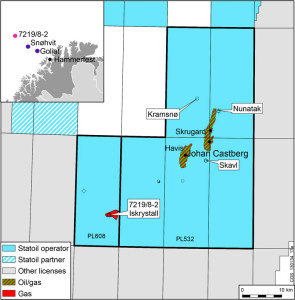Statoil discovers gas in Iskrystall prospect in Barents Sea

Statoil with its partners Eni Norge and Petoro made a gas discovery in the Iskrystall prospect in PL608 in the Barents Sea.
Well 7219/8-2, drilled by Seadrill’s West Hercules, has proved an approximately 656-ft (200-meter) gas column. Statoil estimates the volumes in Iskrystall to be between 6 and 25 million bbl of oil equivalent.
The well was drilled about 19 miles (30 km) southwest of 7220/8-1 Johan Castberg in the Barents Sea and about 93 miles (240 km) north of Hammerfest. The well was drilled at a water depth of 1,129 ft (344 meters) to a vertical depth of 11,096 ft (3,382 meters) below the sea surface and was terminated in the Fruholmen formation in the Late Triassic.
Iskrystall was the second of the four prospects to be drilled in the Johan Castberg area this year with the aim of proving additional volumes for the Johan Castberg field development project. The first prospect Nunatak resulted in a small gas discovery.
“Our main goal was to find oil in Iskrystall, but unfortunately it did not materialize. We still believe we can prove more oil resources in the Johan Castberg area and will continue our exploration effort with two more wells in the Skavl and Kramsnø prospects,” Gro G. Haatvedt, senior vice president exploration Norway, said.
A comprehensive data acquisition program was performed in the Iskrystall well, including coring, wireline logging and fluid sampling. After completion of Iskrystall, the West Hercules rig will move back to the production license 532 to drill the Skavl prospect. Skavl is approximately 3 miles (5 km) south of the Skrugard discovery (now part of Johan Castberg).





The secondary exploration target was to prove petroleum in reservoir rocks from the Late Triassic Age. The well has been drilled in the Barents Sea, about 15 kilometres southwest of the 7220/8-1 Johan Castberg discovery and 230 kilometres northwest of Hammerfest.